Posts: 8,310 Location: Montreal,Quebec,Canada
Fri 28 Sep, 2012 9:44 pm
Doglock Horse pistol ( Undrilled )
I just bought an English Doglock horse pistol with an undrilled touchole as these don't need any licensing or registration as they are not considered to be firearms.
I purchased it from Military Heritage in Canada that sells all their Black powder historical weapons with undrilled toucholes: This means that they can ship to almost any country as they are not considered to be firearms by most countries. (
There may be a few countries where these are treated as being firearms but much fewer than if the touch holes where drilled ).
http://www.militaryheritage.com/index.html
English Civil War Dog Lock Military Pistol:
http://www.militaryheritage.com/pistol5.htm
Where legal and following whatever local regulation (
Check local laws ) a gunsmith can drill the touch holes to make them fully functional but this makes shipping almost anywhere much easier.
It's also very good to have the option to have completely safe versions of these historical firearms for display, around young children or for educational purposes and if one doesn't intend to get into black powder shooting not having the touchole drilled is the only thing different from having the real thing.
I phoned in my order and after a very pleasant conversation with the owner of the company ordered the pistol on Tuesday and had it at my home on Friday: Very friendly and good customer service by the way.
Gordon Fry wrote a feature article on one of these purchased from another source with the touch hole already drilled, and he did a shooting evaluation of it. In his review he mentions a bad fit of the frizzen over the powder pan, but mentions that it was an easy fix to make it fit properly so as to not leave a gap where the priming powder might fall out.
Check out the article as it's very much worth reading:
http://www.myArmoury.com/review_mvt_doglock.html
They must have caught on since the review a few years ago as mine seems perfectly well fitted.
I tried to take pics also showing better how
" HUGE " this pistol really is. :surprised:
Everything feels solid and I'm very happy with it.
 Attachment: 123.04 KB
Attachment: 123.04 KB
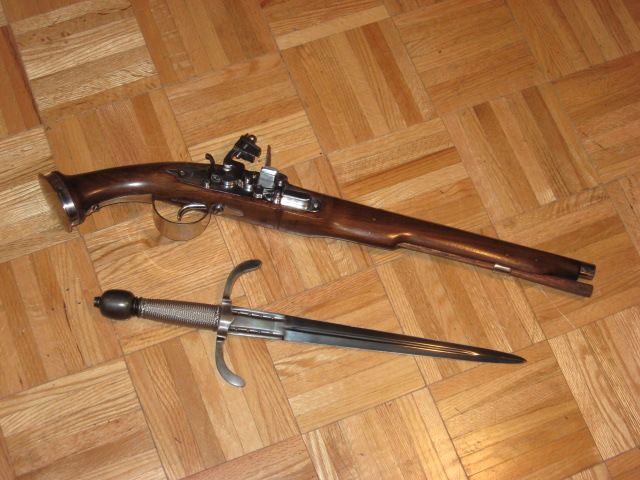
Shown next to Windlass Munich Dagger for scale.
 Attachment: 118.64 KB
Attachment: 118.64 KB
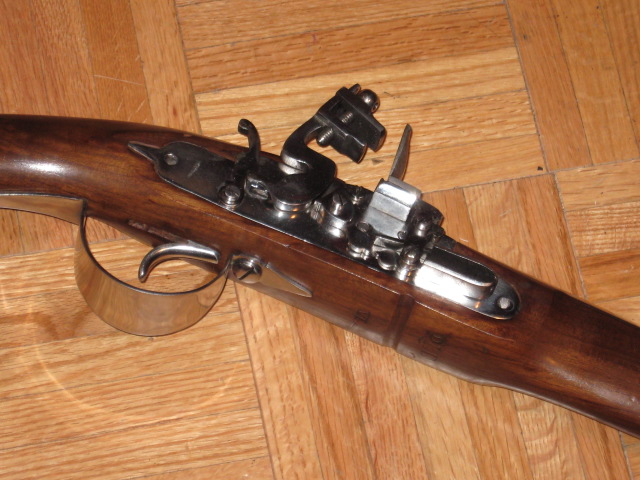
 Attachment: 123.21 KB
Attachment: 123.21 KB
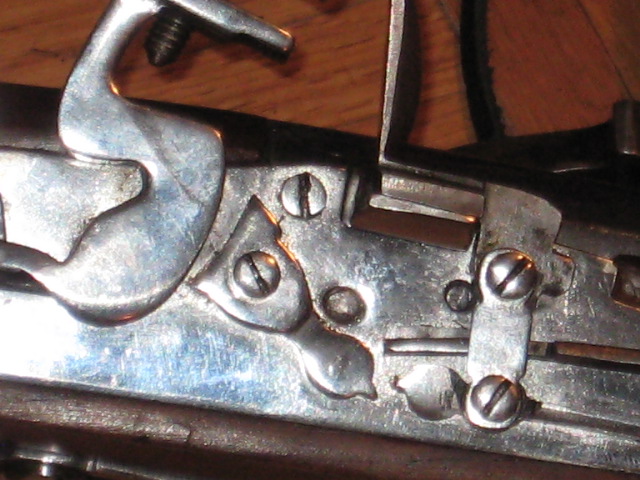
See good fit of frizzen/Pan.
 Attachment: 107.27 KB
Attachment: 107.27 KB
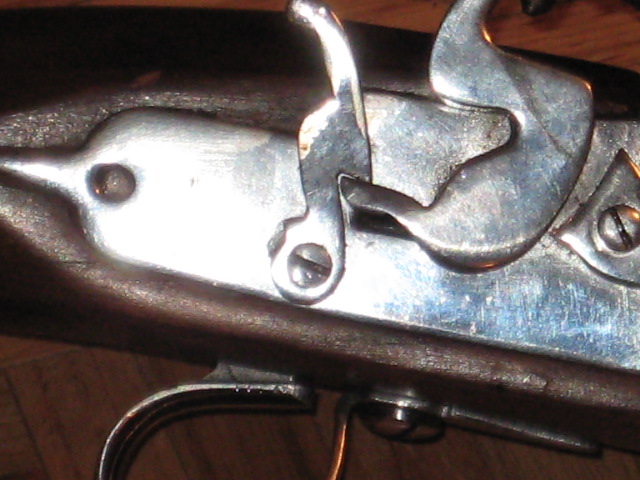
Safety lock, was loose but tightened easily with a screew driver.
 Attachment: 103.11 KB
Attachment: 103.11 KB
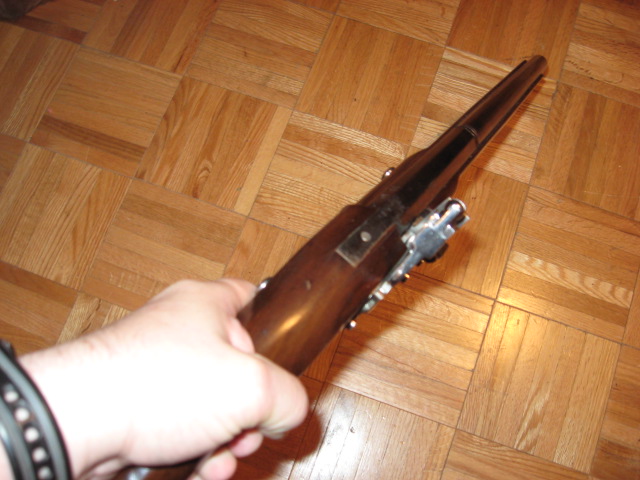
 Attachment: 109.54 KB
Attachment: 109.54 KB
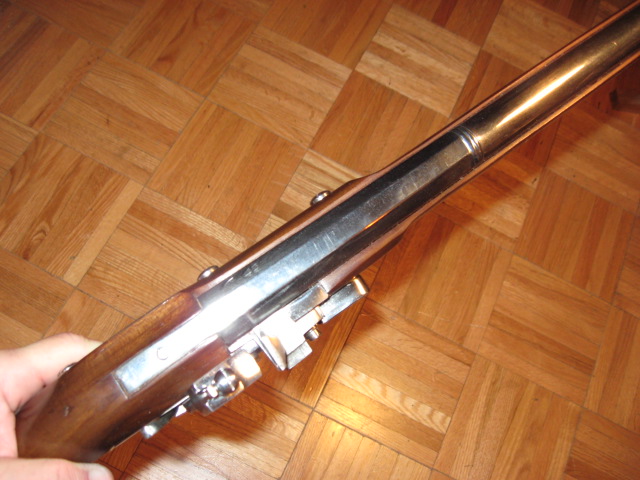
 Attachment: 114.99 KB
Attachment: 114.99 KB
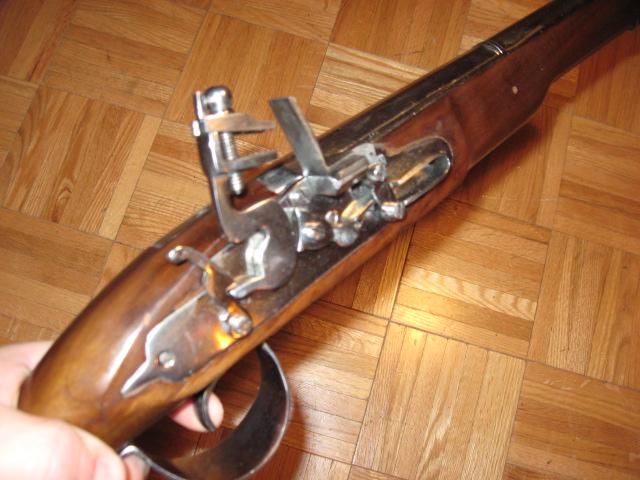
 Attachment: 104.63 KB
Attachment: 104.63 KB
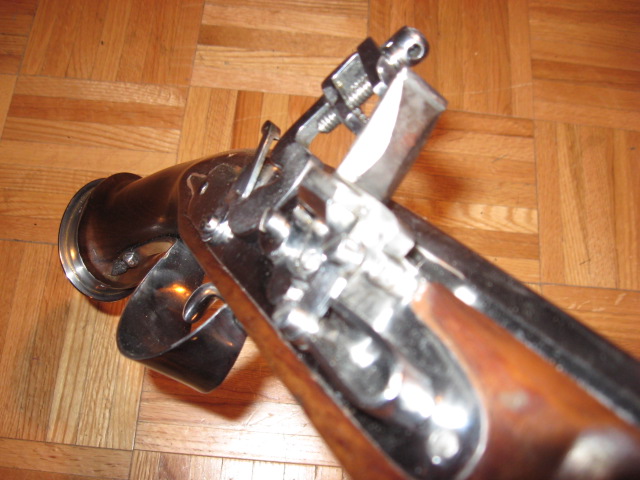
Posts: 8,310 Location: Montreal,Quebec,Canada
Fri 28 Sep, 2012 9:55 pm
Here are a few more pics showing scale. Oh, and this is a very heavy pistol so I assume that a shooting version could use a fairly heavy load and the 16" barrel very high velocity that should be effective against any but the best breast plate armour at close range ..... with no sights close range would be almost touching before firing.
Recoil should be mild because of the weight of the pistol even with a heavy load: Weight is 4 lb. on my food scale.
I see this size of pistol as almost more of a short carbine without a shoulder stock rather than as a normal pistol.
(
With a firing ready version be sure to not excede the maximum recommended load ).
 Attachment: 108.28 KB
Attachment: 108.28 KB
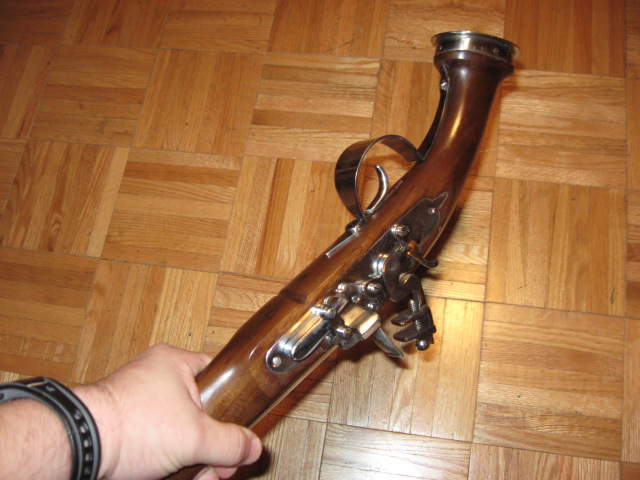
 Attachment: 93.58 KB
Attachment: 93.58 KB
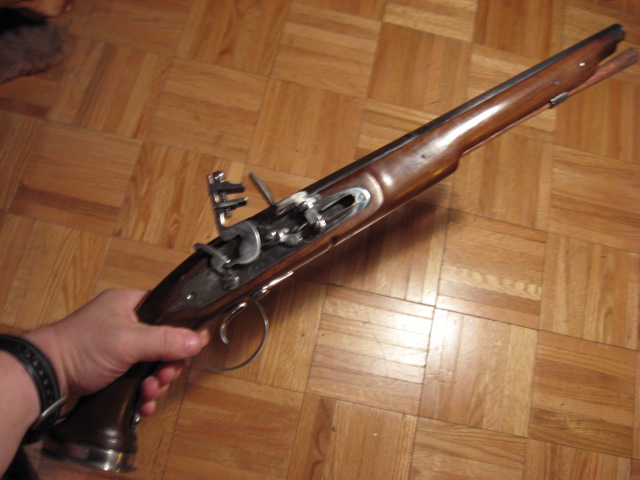
Posts: 271 Location: United Kingdom
Sat 29 Sep, 2012 1:03 am
These Indian-made replicas tend to be good value for money as inert replicas, but not great for shooting: the internal lock mechanisms tend not to be properly hardened and finished to make them durable or reliable for repeated use. The springs can also be a little unreliable over time. Aesthetically, they also suffer from excessively massive woodwork (originals of these are very slim and elegant, not at all bulky or heavy looking).
What is the groove in the woodwork in front of the trigger guard? I've never seen that on an original. Does it serve a purpose?
Also the trigger guard looks a little crudely made from sheet steel. Originals would have been forged and would have a more contoured shape.
As for their use, it was popular to 'touch-fire' (ie. hold the pistol against your opponent and pull the trigger) as a means of defeating the breastplate/buffcoat combination body armour of cavalrymen of the time (and being sure not to miss!).
You really need a pair......!
Julian
Posts: 429 Location: florida
Sat 29 Sep, 2012 2:51 am
I've been wanting to get one of those middlesex village doglocks for years. One of the arms sellers had this pistol buried in a display and i got the chance to finally handle it. The gun is very nice for the 350USD price tag and you really do have to see it to take in how physically large the gun is. The barrel is something along the lines of 16in, with a .75 bore and is surprisingly manageable, but you could see how someones skull could be staved in by that things impressive muzzle. Jean, are you aware that middlesex village trading, the origional importer, will service the lock for the life of the gun? Its just another one of those things that makes it such a great deal
http://middlesexvillagetrading.com/
Posts: 186 Location: WA State
Sat 29 Sep, 2012 9:23 am
Neat. ! + they be smooth bore.
Posts: 28 Location: Bozeman MT
Sun 30 Sep, 2012 10:45 am
Dog lock
You will find that your pistol will take A certain charge anymore and its a waist of powder this is easy to figure out in winter there will be unburnt powder on the snow after you fire if that's case throw less powder till u get it right this will make clean up easier less fowling you know. If you plan on putting a touch hole in her you will want to probably start around 20 grain's of fff goex it's a non corrosive powder, you can call the company and ask as well remember to pull the barrel out and strap it to a log filled with charge and ball make a line of powder light it and run and hide !!! if the barrel dose not bulge or split your good to go and have a weapon that will last you a good while. Ive read on other sights that these Indian barrels have a tendency to split be careful and have fun.[/list]
Posts: 116 Location: Qualicum Beach, B.C., Canada
Sun 30 Sep, 2012 1:13 pm
Very nice Jean, Im jealous! I've been wanting their 9" Sea Service pistol and the Scottish Highland pistol for a while. From the fast delivery Im assuming they have most of these pistols in stock?
Posts: 8,310 Location: Montreal,Quebec,Canada
Sun 30 Sep, 2012 2:13 pm
| Jeff Kaisla wrote: |
| Very nice Jean, Im jealous! I've been wanting their 9" Sea Service pistol and the Scottish Highland pistol for a while. From the fast delivery Im assuming they have most of these pistols in stock? |
Well, I don't know if they have everything fully in stock at all times but I asked if it was in stock before confirming the phone order when I was on the phone. ( So they said it was in stock and it was in stock. ;) :cool: ).
As well, they shipped the very next day, but that is partly because they seem to do their shipping mostly on a Wednesday and I called on a Tuesday .... so ordering later in the week might have slowed things down to a few days more ? But I consider this to be very fast and good customer service.
Reply to various issues and opinions raised in previous posts in no particular order:
For people deciding to make one of their black powder weapons usable they recommend having a gunsmith drill the touch hole and do some safety testing.
The version that Gordon used in his Feature Article was already drilled and seemed to be safe and made by the same makers I believe.
I can't speak to durability if used for a lot of shooting since I have no experience with one that would have had a lot of use.
The trigger guard is sheet steel but it's fairly thick and not fragile and cheap looking, but lets keep in mind the price point, that this pistol is a reproduction of a known period piece that wasn't a highly decorated expensive pistol according to Gordon's article and more an issue work a day gun.
Oh, the groove in the wooden stock in front of the guard I have no idea about the reason for it, or if it's period authentic, or if it was copied from the original pistol on which this one is based ?
If one wanted an " Albion " equivalent quality reproduction the price of the piece would tend to be much higher and I see these as closer to " Windlass " equivalent pieces in quality and/or period authenticity.
Learning to shoot black powder safely and finding optimum loads is certainly important. ;) :D :cool:
Posts: 8,310 Location: Montreal,Quebec,Canada
Sun 30 Sep, 2012 2:24 pm
| Tom King wrote: |
I've been wanting to get one of those middlesex village doglocks for years. One of the arms sellers had this pistol buried in a display and i got the chance to finally handle it. The gun is very nice for the 350USD price tag and you really do have to see it to take in how physically large the gun is. The barrel is something along the lines of 16in, with a .75 bore and is surprisingly manageable, but you could see how someones skull could be staved in by that things impressive muzzle. Jean, are you aware that middlesex village trading, the origional importer, will service the lock for the life of the gun? Its just another one of those things that makes it such a great deal
http://middlesexvillagetrading.com/ |
Note the calibre is 20 gauge or .62 on mine and I don't think they make a .75 one but I could be wrong ?
The middlesex village version is also a good choice if and where there are no Customs clearance issues, legal issues or local registrations to apply for a fully functional one.
Oh, and the pistol was on sale, and is still on sale at the time of writing this, at $299 U.S. and the same $299 Canadian.
Thanks about the servicing information, that can be useful to others buying it from middlesex and they might be willing to service one bought from another vendor but might charge for the work in that case ?
Posts: 1,241 Location: NC
Sun 30 Sep, 2012 7:04 pm
I would be extremely cautious about firing any of these pistols with ball. The barrels are not, to my knowledge, proof tested. As mentioned above, if you want to fire it with ball, remove the barrel and strap it to a wood block, then overload it with powder and a tight patch/ball combination and touch it off with a fuse - remotely - to be sure that the barrel is strong enough. That is the do it yourself version of proving. A competent gunsmith can also do it but it will cost you. Ideally you should have the barrel maganfluxed after proving to be sure there are no cracks or weak spots in the structure but that would probably cost more than the pistol costs.
I have one of the "Murdoch" pistols made by one of the Indian companies currently making the pistols for Loyalist Arms and Middlesex Village.. The half-cock notch in the non-authentic lock is cut in the wrong place on the tumbler meaning the cock does not go back far enough for the pan to close at half-cock. The mainspring is also extremely powerful and a flint lasts just a few fires. Plus the frizzen is not well-hardened and it makes a weak spark, which is a common complaint.
Overall these guns are better for show than shooting and most are over built and not aesthetically pleasing, meaning they do not shine in the show department, at least to someone who is familiar with originals. Their chief advantage is their low cost. Glenn Osborne has commented on these guns in several posts - the Scottish variety any way.
Jean...sorry for all the negativity but I have to call them as I see them.
Posts: 8,310 Location: Montreal,Quebec,Canada
Sun 30 Sep, 2012 8:02 pm
| Lin Robinson wrote: |
I would be extremely cautious about firing any of these pistols with ball. The barrels are not, to my knowledge, proof tested.
Overall these guns are better for show than shooting and most are over built and not aesthetically pleasing, meaning they do not shine in the show department, at least to someone who is familiar with originals. Their chief advantage is their low cost. Glenn Osborne has commented on these guns in several posts - the Scottish variety any way.
Jean...sorry for all the negativity but I have to call them as I see them. |
( Edited down the quote because the whole thing can be read just above this post. ;) ).
Since I purchased mine just for show only it doesn't really make too much of a difference for me, but it is a note of caution for those buying the firing kind to be prudent before using if they have not been proof tested.
So I don't mind at all " the negativity " if it motivates people to be better safe than sorry. :cool:
If other people have had good experiences with the middlesex village shooting versions, and no " accidents ", they should also chime in as I'm curious.
Also posting sources for " proofed " black powder pistols of equal or better quality would also be of general interest in this Topic or in a new Topic I think.
EDITED: From the FAQ page of Middlesex Village site: http://www.middlesexvillagetrading.com/faq.shtml
| Quote: |
A: No. Here in the US, there are no proof houses. I checked with SAAMI as to their reccomendations about proofing. ("Sporting Arms and Ammunition Manufacturer's Institute", the organization who sets standards for such things)
Here was the response:
"SAAMI is currently working on setting standards for muzzleloading guns. There is no proof standard at this time... Cartridge guns are proofed at 130% to 140% of service load pressures. Where and how proofing of muzzleloaders will be done is not yet set."
What does this mean? It means that here in America, there are no standards to proof barrels to, nor proof houses to do the testing. In countries where there are proof laws and proof houses (like the UK and Germany), these routinely pass proof testing.
If you really, really want a muzzleloader to be proof tested, we can perform that task for a fee of $50. The gun barrel will be measured, test fired with double the service load (far in excess of Italian standards that are only 130% of service load) and measured again. The barrel will be marked with our stamp and you will get a copy of the test report. We keep a copy of the test report on file here.
Back to top |
If only for peace of mind paying the extra $50 for proof testing might be a good idea .... and probably more important for an undrilled touchole version just in case the quality control is taken less seriously by the makers.
Posts: 429 Location: florida
Mon 01 Oct, 2012 5:52 am
| Jean Thibodeau wrote: |
Note the calibre is 20 gauge or .62 on mine and I don't think they make a .75 one but I could be wrong ?
The middlesex village version is also a good choice if and where there are no Customs clearance issues, legal issues or local registrations to apply for a fully functional one.
Oh, and the pistol was on sale, and is still on sale at the time of writing this, at $299 U.S. and the same $299 Canadian.
Thanks about the servicing information, that can be useful to others buying it from middlesex and they might be willing to service one bought from another vendor but might charge for the work in that case ? |
I am pretty sure that Middlesex village trading is the original importer of the firearms, but military heritage might be cutting out the middle man and importing from the same factory over in india. Based on Middlesex's website, it seems that they are outsourcing the production of the guns based on their own designs, rather than buying pre produced firearms from some bulk seller in New Delhi. You might want to send middlesex an email to see if they supply the guns sold through military heritage, and if they would cover the lock mechanism.
Posts: 1,191 Location: Kingston, Washington
Mon 01 Oct, 2012 11:56 am
Jean;
I've had several of these "English Lock" pistols from Middlesex Village (something like a dozen, most of which I've passed on to other folks), and shot them with both blanks and with shot. I've had no problems, but then I'm not charging them with 60 grains of powder either. 40 grains of 2fg is more than enough, as I don't feel a need to test any armour at the moment... (besides, I do that with my Dale Shinn Wheellock anyway...THAT one will take a hefty charge! :) )
True, they are not "proofed" (although they DO sport spurious period proof marks from both England and Ireland!), but at least the ones sold by Middlesex are designed to be fired with ball, so again with a light charge I wouldn't be too concerned. On the other hand, following Lin's advice of "proofing" it yourself would be prudent if you intend to do any serious shooting of the piece, i.e. with a serious service load.
I of course have no idea as to the metallurgy involved, but I would seriously doubt that the ones sold without a touch hole drilled would be of significant difference from those sold with. It would cost more to try to set up two different production lines than it would to just skip one step. I could be wrong though, so prudence suggests a proof-load to find out, should you wish to do any shooting with serious charges.
On the other hand, most firearms today, other than those manufactured in Belgium, Britain and Italy aren't proofed prior to sale. The laws were passed to ensure customer safety in a day and age when tracking down the manufacturer and suing the bajeezuz out of him was somewhat more difficult in the event of catastrophe. Now, however, having a plague of lawyers in our midst, proof tests are much less a requirement. But still, prudence is incumbent upon the user.
They ARE a bit over-built, no question. Real ones, and ones made by Dale Shinn, are significantly more slim in the stock than these are. Likewise, the "butt cap" is wrong, as it should be a simple band around the "knob" at the butt to hold the wood together when stress is applied (such as when clubbing your opponent on the head). So just think of these as a fairly complete "kit", in which the hard work (inletting and fitting) has all been done, all you have to do is take some wood off of the stock and re-finish it with something other than shellac. Replacing the butt-cap is optional.
I find that they are definitely a piece to fill a missing hole in the armoury of the reenactor. There just aren't many makers of such things out there who can do a truly decent job of it (Dale Shinn is retired, John Buck is somewhat overwhelmed, I believe, but worth checking into), so for an inexpensive but still serviceable piece, it's a godsend. How else are you going to fill the saddle-pipes of your Troop of Horse otherwise? The locks are pretty darned decent, really, and as long as you look upon the complete item as a starting point, you would be hard pressed to do wrong with one of them.
Cheers!
Gordon
You
cannot post new topics in this forum
You
cannot reply to topics in this forum
You
cannot edit your posts in this forum
You
cannot delete your posts in this forum
You
cannot vote in polls in this forum
You
cannot attach files in this forum
You
can download files in this forum









